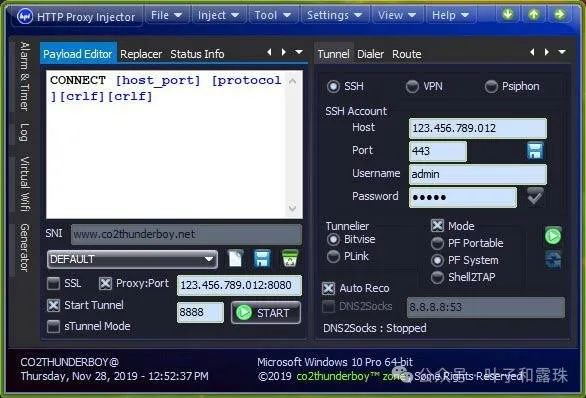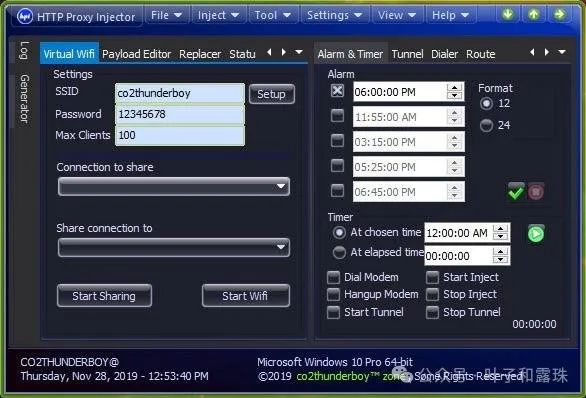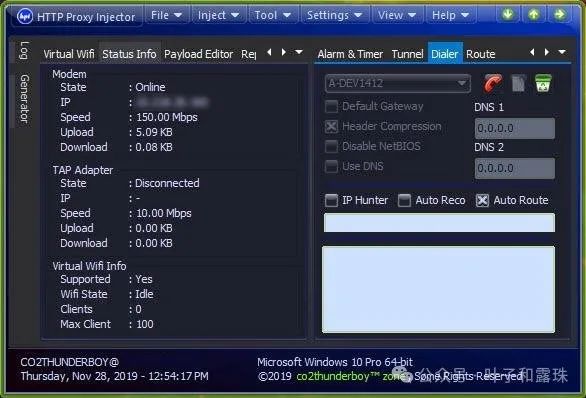HTTP Proxy Injector: A Powerful HTTP Proxy Injection Tool
HTTP Proxy Injector is a powerful tool for HTTP request proxying and injection, helping developers, testers, and security researchers intercept, modify, and redirect HTTP/HTTPS requests. It is widely used in development debugging, security testing, and network analysis. This article will comprehensively introduce the core features, working principles, usage scenarios, and practical application examples of HTTP Proxy Injector.

1. Overview of HTTP Proxy Injector
HTTP Proxy Injector is a Man-in-the-Middle (MITM) proxy tool that sits between the client and the server, capable of intercepting, viewing, and modifying all HTTP/HTTPS communications. Unlike ordinary proxies, it not only forwards requests but also provides rich injection and modification capabilities.
Basic Working Principle:
-
The client is configured to use HTTP Proxy Injector as a proxy.
-
All HTTP/HTTPS requests are first sent to the Injector.
-
The Injector can forward requests as is or modify them before forwarding.
-
The server responses are also processed by the Injector before being returned to the client.
This architecture makes HTTP Proxy Injector a powerful tool for development debugging and security testing, especially useful in the following scenarios:
-
Decoupled Frontend and Backend Development: Solving cross-origin issues in the development environment.
-
API Debugging: Viewing and modifying API requests/responses.
-
Security Testing: Testing web applications against various injection attacks.
-
Performance Analysis: Measuring request response times and analyzing performance bottlenecks.
2. Core Features
HTTP Proxy Injector offers a range of powerful features that set it apart from similar tools:

1. Request/Response Interception and Modification
HTTP Proxy Injector can intercept all HTTP/HTTPS requests and responses, allowing users to view and modify any part of them, including:
-
Request methods (GET/POST/PUT/DELETE, etc.)
-
URL paths and query parameters
-
Request headers and response headers
-
Request bodies and response bodies
-
Status codes and status messages
This capability is particularly useful for debugging complex API interactions, allowing developers to test various edge cases without modifying client code.
2. HTTPS Decryption
Unlike other simple proxy tools, HTTP Proxy Injector can decrypt HTTPS traffic (requires CA certificate installation). This allows it to view and modify encrypted HTTPS communications, which is crucial for debugging secure connections and testing SSL/TLS configurations.
3. Breakpoint Debugging
The Injector provides powerful breakpoint functionality, allowing users to pause communication before requests are sent and before responses are returned, enabling manual content modification. This is particularly useful for testing various exceptional cases and edge conditions.
4. Request Replay and Batch Testing
Users can save specific requests and replay them multiple times or use the “Repeat Advances” feature to customize the number of repetitions and intervals, which is very helpful for interface stress testing and stability validation.
5. Traffic Redirection
HTTP Proxy Injector supports various traffic redirection methods:
-
Map Remote: Redirect requests to another remote server.
-
Map Local: Map requests to local files.
-
Rewrite: Automatically modify requests/responses based on rules.
These features are particularly useful in parallel frontend and backend development, API simulation, and fault injection testing.
6. Automation Script Support
The advanced version of the Injector supports writing automation rules using scripting languages like JavaScript, enabling complex traffic modification logic and significantly improving testing efficiency.
3. Installation and Configuration
1. Installation Methods
HTTP Proxy Injector typically offers multiple installation methods:
-
Standalone Application: Directly download and install the package.
-
Node.js Module: Install via npm (e.g.,
<span>http-proxy-middleware</span>). -
Browser Extension: Some lightweight features can be used as a browser extension.
For development purposes, it is recommended to use the Node.js module method for easier integration into existing development environments:
npm install http-proxy-middleware --save-dev2. Basic Configuration
Configuring HTTP Proxy Injector typically requires the following steps:
-
Set Listening Port: Default is usually 8888.
-
Install CA Certificate(if HTTPS decryption is needed).
-
Configure Client: Point the browser or application’s proxy settings to the Injector.
-
Set Filtering Rules: Determine the types and ranges of requests to intercept.
An example of a basic Express server integration configuration:
const express = require('express');
const { createProxyMiddleware } = require('http-proxy-middleware');
const app = express();
app.use('/api', createProxyMiddleware({
target: 'http://api.example.com',
changeOrigin: true,
pathRewrite: {
'^/api': '' // Remove /api prefix
}
}));
app.listen(3000);4. Typical Usage Scenarios
1. Development Debugging
In decoupled frontend and backend development, HTTP Proxy Injector can:
-
Solve cross-origin issues: Proxy API requests to the same-origin address.
-
Simulate API responses: Use local mock data while the backend service is not completed.
-
Debug mobile applications: Debug mobile applications via WiFi proxy.
2. Security Testing
Security researchers use the Injector for:
-
XXE Injection Testing: Testing XML External Entity processing vulnerabilities.
-
Request Tampering: Modifying parameters to test input validation.
-
Sensitive Information Capture: Checking if sensitive data is included in requests.
-
SSL/TLS Testing: Validating encryption strength and certificate configuration.
XXEinjector is a Ruby-based XXE injection tool that can utilize proxies for various out-of-band attack tests.
3. Performance Optimization
Through the Injector, one can:
-
Measure request response times.
-
Analyze request/response sizes.
-
Simulate slow networks (throttle feature).
-
Identify unnecessary requests.
4. Interface Automation Testing
Combined with automation scripts, it can achieve:
-
Batch interface testing.
-
Simulating exceptional scenarios.
-
Automated assertion validation.
-
Performance benchmark testing.
5. Advanced Usage Tips
1. Conditional Breakpoint Settings
Unlike ordinary breakpoints, conditional breakpoints only trigger when specific conditions are met, such as:
-
Only intercept requests containing specific cookies.
-
Only modify responses with a status code of 500.
-
Only capture POST requests.
This precise control can greatly enhance debugging efficiency.
2. Automation Script Injection
By writing scripts, automated modifications can be achieved, such as:
-
Automatically adding authentication headers to all requests.
-
Modifying response data for specific APIs.
-
Dynamically generating responses based on request content.
// Example: Automatically add Authorization header
function onRequest(req, res) {
if(req.url.includes('/api/')) {
req.headers['Authorization'] = 'Bearer xxxx';
}
}3. Simultaneous Debugging on Multiple Devices
HTTP Proxy Injector supports proxying multiple devices simultaneously, facilitating debugging:
-
Ensure all devices are on the same network.
-
Configure devices to use the computer’s IP and Injector port as the proxy.
-
Differentiate traffic from different devices in the Injector.
4. CI/CD Integration
Injector can be integrated into continuous integration processes to achieve:
-
Automated interface testing.
-
Security scanning before deployment.
-
Performance benchmark testing.
6. Security and Privacy Considerations
When using HTTP Proxy Injector, the following security and privacy issues should be noted:
-
HTTPS Decryption Risks: Decrypting HTTPS requires installing a custom CA certificate, which can reduce connection security.
-
Sensitive Data Exposure: All traffic will be viewed in plaintext, potentially leaking sensitive information.
-
Legal Compliance: Intercepting others’ communications without authorization may violate laws.
-
Disable in Production Environments: Such tools should never be used in production environments.
It is recommended to use HTTP Proxy Injector only in development, testing, or explicitly authorized security assessments, and ensure:
-
Remove CA certificates after use.
-
Do not intercept real user traffic containing sensitive information.
-
Comply with relevant laws and company policies.
7. Comparison with Similar Tools
Although HTTP Proxy Injector is powerful, there are other similar tools available:
-
Charles Proxy: Commercial tool, user-friendly interface, comprehensive features.
-
Fiddler: Free tool for Windows, supports script extensions.
-
Burp Suite: Focused on security testing, free community version available.
-
mitmproxy: Open-source command-line tool, highly customizable.
When choosing a tool, consider:
-
Platform support (Windows/macOS/Linux).
-
Complexity of required features.
-
Budget (commercial tools vs. open-source tools).
-
Learning curve and usage habits.
8. Conclusion
HTTP Proxy Injector is a powerful HTTP proxy injection tool that provides developers, testers, and security researchers with unprecedented control and insight into requests/responses. Whether solving cross-origin issues in development, debugging complex API interactions, or conducting security testing and performance analysis, it can significantly enhance work efficiency.
However, with great power comes great responsibility. It is essential to remain vigilant about security and privacy issues when using such tools, ensuring they are only used in appropriate environments and authorized scopes. For team development, it is advisable to establish clear usage guidelines to avoid security risks from misuse.
As web technologies and the API economy rapidly evolve, the importance of tools like HTTP Proxy Injector will only increase. Mastering its usage techniques will become an essential skill for modern web developers and security engineers.
